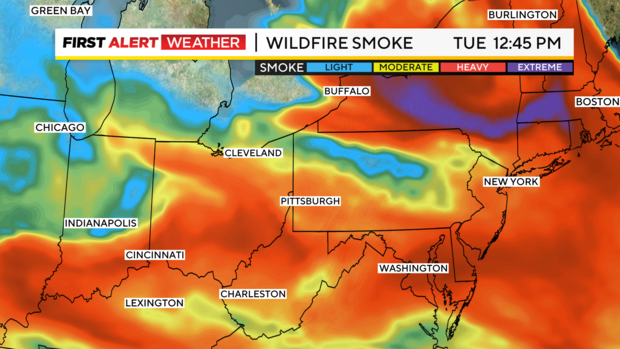Why were the sun and moon red on Tuesday? Wildfire smoke — how the sky changes color

People in New York City and the northeastern United States woke up Tuesday morning to a rare sight. Depending on the time of day, early risers reported seeing either the Moon or the Sun taking on a reddish glow. For the first time in weeks, both the sun and moon skies have turned red across parts of the Northeast and Pacific Northwest as wildfires in eastern and western Canada continue to send smoke across borders. isn’t it.
Canada is experiencing one of the worst wildfire seasons on record, with more than 6.7 million acres burned so far this year, officials said at a press conference last week. Fires are particularly severe now in the eastern provinces of the country, with wildfires raging in Quebec and Nova Scotia, displacing about 14,000 people. CBC News report.
Rotating winds around a stationary low pressure system over New Brunswick, Nova Scotia, and the eastern provinces of Prince Edward Island, known as the Canadian Sea, are channeling wildfire smoke toward the northeastern United States, science editors say. said Matt Sitkowski of The Weather Channel chief told CBS News on Tuesday.
Victor J. Blue/Bloomberg via Getty Images
Sitkowski says the smoke makes the sun and moon appear red behind a hazy gray sky. Because the color of the sky is determined based on how sunlight interacts with the number and size of particles in the air, it is altered by smoke penetration, introducing more particulate matter into the atmosphere. increase.
“For example, the sky is blue because small particles in the atmosphere scatter short wavelengths of the visible light spectrum more strongly than long wavelengths,” Sitkowski said, noting that blue light has short wavelengths and red light has He pointed out that the wavelength is long.
“The presence of smoke in the atmosphere not only darkens the sun, but also increases the amount and size of particulate matter in the atmosphere, allowing shorter wavelengths to be absorbed and longer wavelengths to reach our eyes. will be,” he explained.
Why am I getting an air quality warning?
A series of events followed this week as a red Sun and Moon appeared in the northeastern United States. air quality alert Millions were affected on Tuesday, some living as far west as Ohio and Missouri and as far south as North Carolina.
air quality health advisory issued The areas affected include the New York City metropolitan area, lower Hudson Valley, upper Hudson Valley, Adirondacks, eastern Lake Ontario, and central Lake Ontario, according to the New York State Department of Environmental Protection. Alerts are in Delaware, Maryland, MassachusettsPhiladelphia and much of North Carolina, as well as Columbus and St. Louis.
Officials said air quality would be considered “unhealthy for sensitive groups” in the areas where the alert was issued on Tuesday, but would likely not harm the general public. Sensitive groups, including the elderly, children, and those with asthma and other pre-existing respiratory conditions, are advised to limit prolonged strenuous outdoor activity while health advisories are in effect.
Generally, the Air Quality Index measures pollution by the amount of solid and liquid particulates found in a particular airspace, and weather officials acknowledged that the pollution that occurred Tuesday was associated with at least a plume of smoke from bottom. 100 wildfires Fires erupt across the Quebec-Ottawa border.
“As smoke from Canada’s wildfires moved south, air quality declined precipitously over much of the northeast,” the National Weather Service wrote in an article. Tweet. “Poor air quality can be dangerous. Check the air quality forecast before spending time outdoors. Be careful not to do more harm than good.”
Officials expect smoke from Canada’s wildfires to continue to be blown by winds to the northeast as early as Wednesday. Similar damage occurred in the Midwest from cross-border wildfires earlier this week, the Minnesota Pollution Control Department said in a statement. Tweet “Due to very light winds, a band of smoke from the Quebec wildfires will continue to linger in central and southeastern Minnesota today,” it said Monday.
What Causes Wildfires in Canada?
There were 413 wildfires burning across Canada as of Sunday. CBC News Citing Canadian Natural Resources official Michael Norton and other federal officials, he said earlier this week that he had no idea that wildfires of such magnitude would spread from coast to coast in the country at this time of year. said it was unusual. Although Canada’s wildfires are typically caused by lightning strikes, Norton said there have been cases of much larger fires caused by man-made fires.
The map below, produced by CBS-affiliated radio station KDKA on Tuesday afternoon, shows the extent of smoke currently flowing into the United States from wildfires in Canada.
KDKA Meteorological Center
“Wildfire smoke can travel thousands of miles and remain in the air for days,” Sitkowski said. “How the smoke spreads is a function of larger weather patterns, such as wind direction and strength.” “Smoke is also present at different levels of the atmosphere, and it’s most dangerous to our health when it’s close to the ground.”
https://www.cbsnews.com/news/why-are-the-sun-moon-red-smoke-wildfire/ Why were the sun and moon red on Tuesday? Wildfire smoke — how the sky changes color





